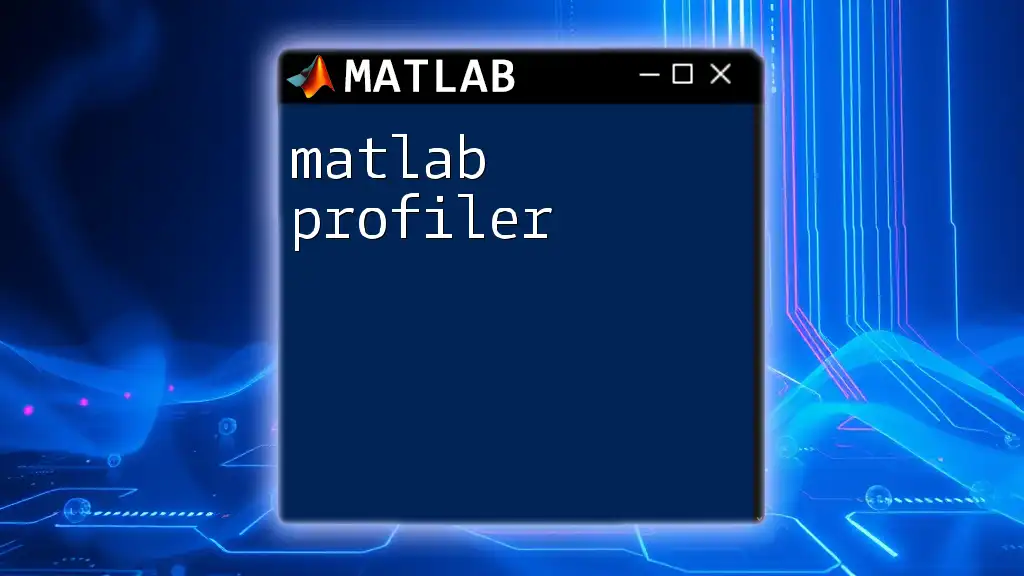The `parpool` function in MATLAB creates a parallel pool of workers to enable parallel computing, allowing users to execute multiple tasks simultaneously for faster performance.
Here’s a code snippet to create a parallel pool with 4 workers:
parpool(4);
What is parpool?
`parpool` is a function in MATLAB that allows users to create a pool of parallel workers, enabling you to distribute computations across multiple computing resources. This is particularly important in contexts where tasks can be executed concurrently, resulting in significant time savings and enhanced computational efficiency.
Benefits of using `parpool`
Utilizing `parpool` brings several advantages:
- Increased Efficiency: By enabling the execution of multiple tasks at once, `parpool` allows for more efficient use of available resources.
- Improved Computational Speed: Tasks that may take a long time to complete sequentially can run in parallel, drastically reducing overall execution time.
- Ability to Handle Larger Datasets: Parallel processing enables you to work with more extensive datasets and complex algorithms that might be too cumbersome for single-threaded execution.

Getting Started with parpool
Setting Up Your Environment
Before diving into the use of `parpool`, you need to ensure that your MATLAB environment is properly set up:
- Required MATLAB Toolboxes: Make sure that you have the Parallel Computing Toolbox installed, as this toolbox contains all necessary functions for parallel computations.
- Pre-requisites for using `parpool`: It's essential to have a system that meets the recommended specifications, particularly regarding processor speed and RAM.
Creating a Parallel Pool
Creating a parallel pool is straightforward. The basic syntax for initiating a parallel pool is:
myPool = parpool;
You can specify the number of workers (parallel threads) to use by adding an argument:
myPool = parpool(numWorkers);
Example: Creating a Pool with 4 Workers
Here’s how you can create a parallel pool with four workers:
myPool = parpool(4);

Managing the Parallel Pool
Querying the Pool Status
To check if a parallel pool is currently open, you can use the following command:
poolSize = numlabs;
This command will provide you with the number of workers currently running.
Closing the Parallel Pool
Once you no longer need the workers, it is essential to close the pool to free up resources. You can close a parallel pool using:
delete(myPool);
Importance of Closing Unneeded Pools
Keeping a parallel pool open consumes system resources, which can lead to inefficiencies and higher operational costs. Closing a pool when it’s not in use contributes to better resource management and energy efficiency.
Dynamic Work Management
MATLAB allows you to dynamically manage the number of workers in an existing pool. This includes adding or removing workers as needed.
For instance, you might want to shrink the number of workers in your pool:
p = gcp('nocreate'); % Get current pool
delete(p);
This command helps in efficiently adapting the parallel pool based on the current workload.

Using parpool with Parallel Computing Tasks
Executing Parallel Tasks
One of the primary functions you’ll use with `parpool` is `parfor`, which enables you to run a loop in parallel. Consider the following example of how to use `parfor` to execute tasks concurrently:
parfor i = 1:10
% Your computations here
end
Combining parpool with Other Parallel Functions
Using `parpool` in conjunction with other parallel computing functions can significantly enhance performance.
- When to Use `parpool` with `batch`, `parfeval`, and `pararrayfun`: Here are examples showcasing how these commands interact with `parpool`.
`batch` Example
Suppose you want to run a function asynchronously while using a specified pool size. You can utilize the `batch` function as follows:
job = batch('myFunction', 'Pool', 4);
This command will execute `myFunction` in a batch job utilizing four workers.
`parfeval` Example
`parfeval` allows you to evaluate functions asynchronously while giving you control over the completion of tasks. An example usage could be:
f = parfeval(@myFunction, numOut, inputArgs);
Where `numOut` is the number of output arguments and `inputArgs` are the corresponding input parameters.

Troubleshooting Common Issues
Common Errors and Solutions
When using `parpool`, errors can arise from various sources. Some common problems include:
- Memory-related issues: These occur when tasks require more memory than is available. Optimizing your code for memory usage is essential.
- Incorrect pool sizing: Allocating too many or too few workers can severely affect performance. Begin with a small number of workers and adjust accordingly based on your specific tasks.
- Code hang-ups during execution: This might happen if your tasks are interdependent or if they encounter unexpected errors. Always ensure your tasks are independent where possible.
Performance Optimization Tips
To maximize the benefits of `parpool`, consider the following best practices:
- Defining tasks efficiently: Break down your problem into smaller, independent functions that can easily run in parallel.
- Load balancing: Distributing tasks evenly among workers can help utilize all available resources effectively and prevent bottlenecks.
- Monitoring performance through MATLAB Profiler: Use this tool to identify which parts of your program are obstructing performance, allowing you to fine-tune your parallel processing.

Conclusion
In conclusion, MATLAB `parpool` allows users to harness the power of parallel computing, transforming how computations are executed. Its ability to manage multiple processes concurrently means that users can significantly speed up their workflow, handle larger datasets, and enhance overall productivity.
Taking the first steps into using `parpool` and implementing parallel computing techniques can yield long-lasting benefits for your projects and research. Embrace this powerful feature of MATLAB to elevate your computational tasks.

Additional Resources
For further information and in-depth details, be sure to check out the official MATLAB documentation on `parpool`. There you will find comprehensive guides, examples, and best practice recommendations.
Consider exploring additional reading materials such as books, tutorials, and online courses to deepen your understanding and refine your skills in utilizing parallel computing effectively.

FAQs
- What is the maximum number of workers you can have in a pool?
- Can `parpool` run on a single machine?
- What are the costs associated with using `parpool`?
Delve into MATLAB `parpool` today and unlock new levels of efficiency in your computational tasks!

















